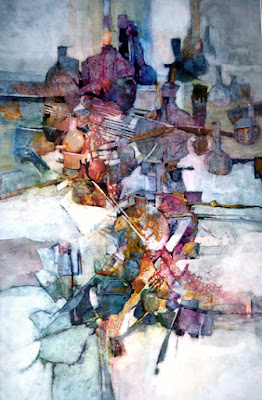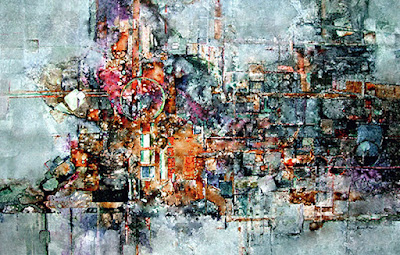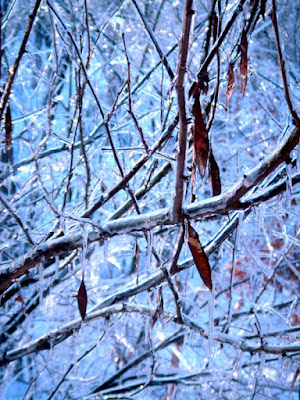 Almost 10 years ago, I attempted to paint with watercolors on YUPO. Two years of frustration finally resulted in a wonderful 'ah ha!' moment, and I was really hooked. Back then, no one gave workshops about how to paint on YUPO, so I plodded and experimented on my own.
Almost 10 years ago, I attempted to paint with watercolors on YUPO. Two years of frustration finally resulted in a wonderful 'ah ha!' moment, and I was really hooked. Back then, no one gave workshops about how to paint on YUPO, so I plodded and experimented on my own. Now on video you can watch George James demo the many, many ways paint can be used to transform the slick YUPO surface. Creative Catalyst Productions produced the videos, and James also gives workshops throughout the US. Several of my friends have taken his workshops and learned a bunch.
The painting below started out as a workshop demo and was awarded Best Of Show at Viewpoint 2004 at the Cincinnati Art Club. The painting on the right is more recent and received a first place in another show after getting a rejection notice for Viewpoint 2006. My inspiration for the one on the right came when my friend, Ginger, donated some chemistry flasks to my studio still life collection.
"UNDERGROUND RAILROAD" on YUPO 40 x 26", and above, to the right, "PARTY TIME" on YUPO 26 x 40"












 Today's class focused on how to best create a landscape in watercolor. The demo painting is getting close to completion. The lightest, biggest, furthest away shapes were painted first, followed by closer, light shapes, like the water areas. Darker values were added next - the cypress and dark foliage tree line. Details had to wait until medium sized shapes were finished. There's more to do but the basic areas are in. I'll include a value study and the original reference photo in the next post but wanted to get this on line for people who watched the demo today.
Today's class focused on how to best create a landscape in watercolor. The demo painting is getting close to completion. The lightest, biggest, furthest away shapes were painted first, followed by closer, light shapes, like the water areas. Darker values were added next - the cypress and dark foliage tree line. Details had to wait until medium sized shapes were finished. There's more to do but the basic areas are in. I'll include a value study and the original reference photo in the next post but wanted to get this on line for people who watched the demo today.




